Ski Bike
When I first suggested the idea of merging skiing with bikepacking to Diego, his round blue eyes widened, and his eyebrows shot up in surprise. Looking back, I can understand his reaction — I was improving my ski touring skills at that moment, while he was new to bikepacking. He had recently acquired his first touring bike and had only a handful of short pannier-packing experiences. The idea of blending off-road cycling, camping, and skiing felt too big to comprehend.
But that was a few years ago. Diego is someone who requires time to mull over an adventure, to mentally prepare for it, whereas I am the antithesis — impulsive. Life, I’ve come to realize, is all about balance. I embrace adventure; he delves into technique. Thus, weʼve found the right match.
While traveling by bike is straightforward in terms of terrain, security, and technique, ski touring requires quite a lot of knowledge regarding each of them. Nevertheless, both of the sports have quite a lot in common. The main one? The adventure itself. Our initial experiment that intertwined these two pursuits granted us insights into our limits, appropriate gear, and the crucial considerations of timing, location, and terrain selection. We agreed we wanted to ride off-piste, loaded with camping and ski touring gear, with the goal of spending a few nights in the Spanish Pyrenees.
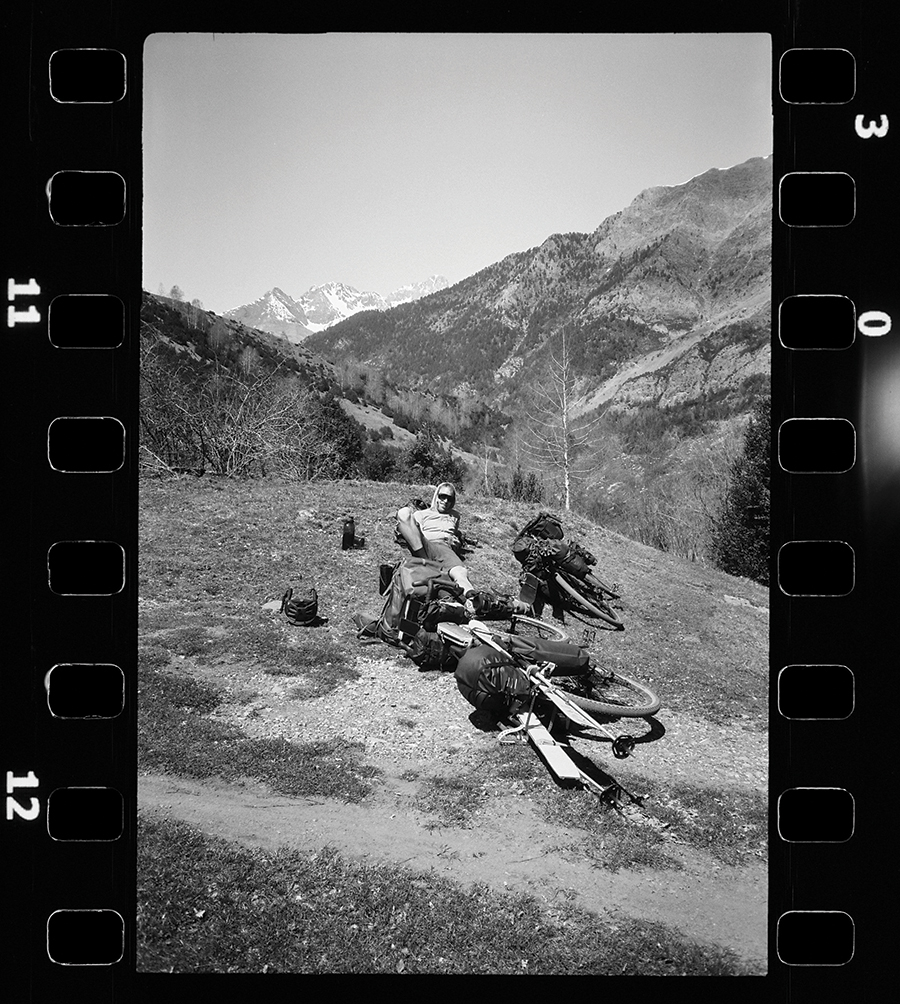
I still hadn’t gained as much confidence in skiing as I had in bikepacking — this was only my second year hitting the slopes — but Diego felt just the opposite. He has been skiing since he was a little kid, so we both tried to support each other in the sport where we had the most experience.
Our first multisport adventure came in January 2023. We took advantage of the mild winter Europe experienced during the 2022/23 season. It only snowed a few times, and even the ski resorts didn’t have much snow until mid-January, leaving large swaths of grass and gravel exposed and perfect for cycling. As the saying goes, darle la vuelta a la tortilla — “to turn the tables” — so we planned a cool, short adventure to conclude our Christmas holidays.
The snowfall we had in the Pyrenees wasn’t enough to cover the valleys, leaving only the higher peaks at around 6,550 feet blanketed in white. There was some snow, but we needed to be creative to find it. As Diego knows the Pyrenees like the back of his hand, he charted a route that intertwined gravel paths and ski touring. Rehearsal day finally arrived, and we were equally excited and nervous about facing our first gravel-skiing experience ever. During that day we learned a lot, not only about attaching the skis properly to a gravel bike but also about the limits of our bodies. After ascending 2,300 feet with fully loaded bikes, we left the bikes and the rest of the gear we did not need on the grass. We wore skis, boots, proper clothing, and a backpack with all the safety gear you need for ski touring plus some food and water. By midday, I was dehydrated and exhausted; it turns out combining these sports in the same day requires a lot of effort and great fitness and conditioning. As it was winter, days were short and we had to be aware of the natural light and conditions of the snow as it kept changing throughout the day.
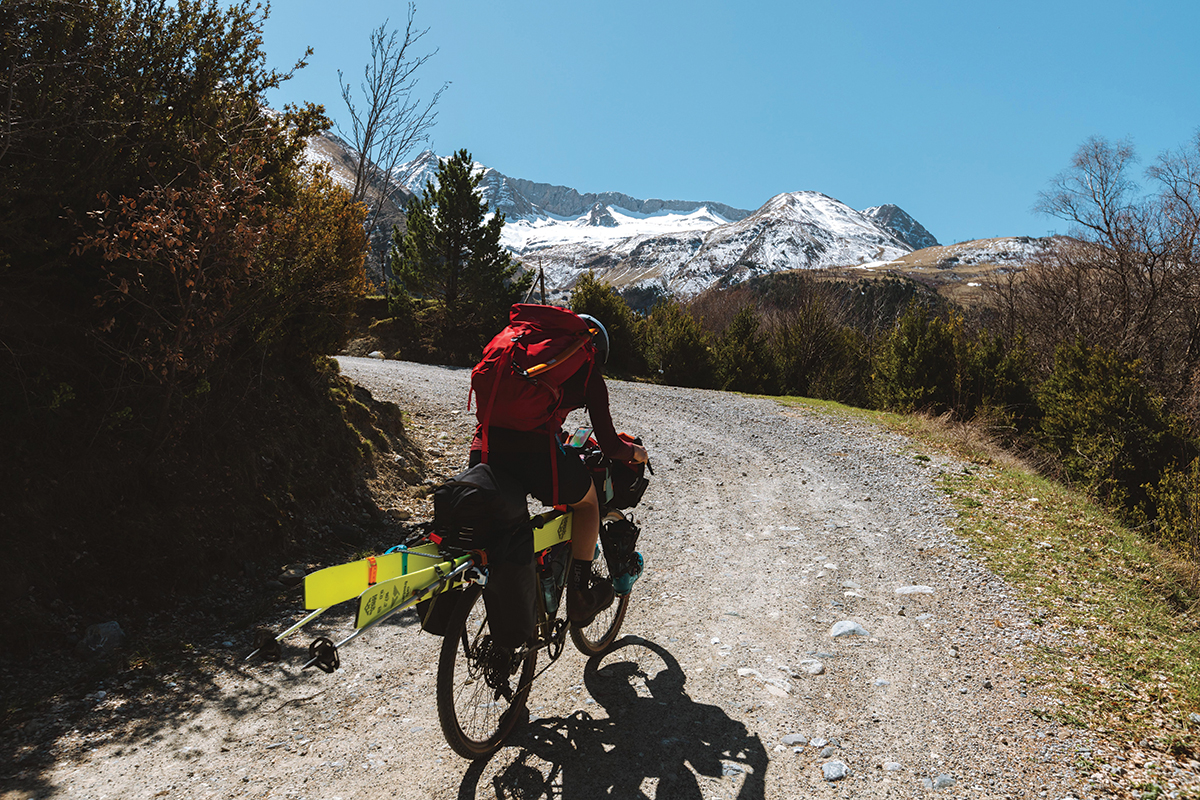
Now that we’d done a successful test run, it was time to stretch out the adventure. This second experience felt much better than the first. The days were longer, our gear-packing skills were refined, and our confidence in both sports was growing. Easter was the perfect time to take some days off in a magical and remote corner of the Spanish Pyrenees: the weather was on our side with shiny days and the snow was still playful considering the little precipitation we had during the winter.
Preparations started days ahead, given the meticulous planning necessary. As time went by, we found ourselves loading gear next to the Bubal Dam in the stunning Tena Valley. Two fully loaded gravel bikes with food for four days, camping gear, and ski touring stuff set us up to have probably the most amazing days of the last winter. The first miles are always to get adapted to the weight and be mentally prepared for the adventure ahead. I felt excited, nervous, and intrigued, but somehow happiness was my main state. Our bikes wobbled under the load, passing cars with mutual respect during the first miles before we turned onto the gravel mountain trail. Once we left the asphalt, jackets were removed as the sun’s rays began to warm our skin. We had almost 3,000 feet of climbing ahead, promising breathtaking views and no urgency to reach the small open shelter we found on the map. Our fingers were crossed, hoping the shelter — which cannot be reserved — wasn’t already occupied. We carried our tent just in case.
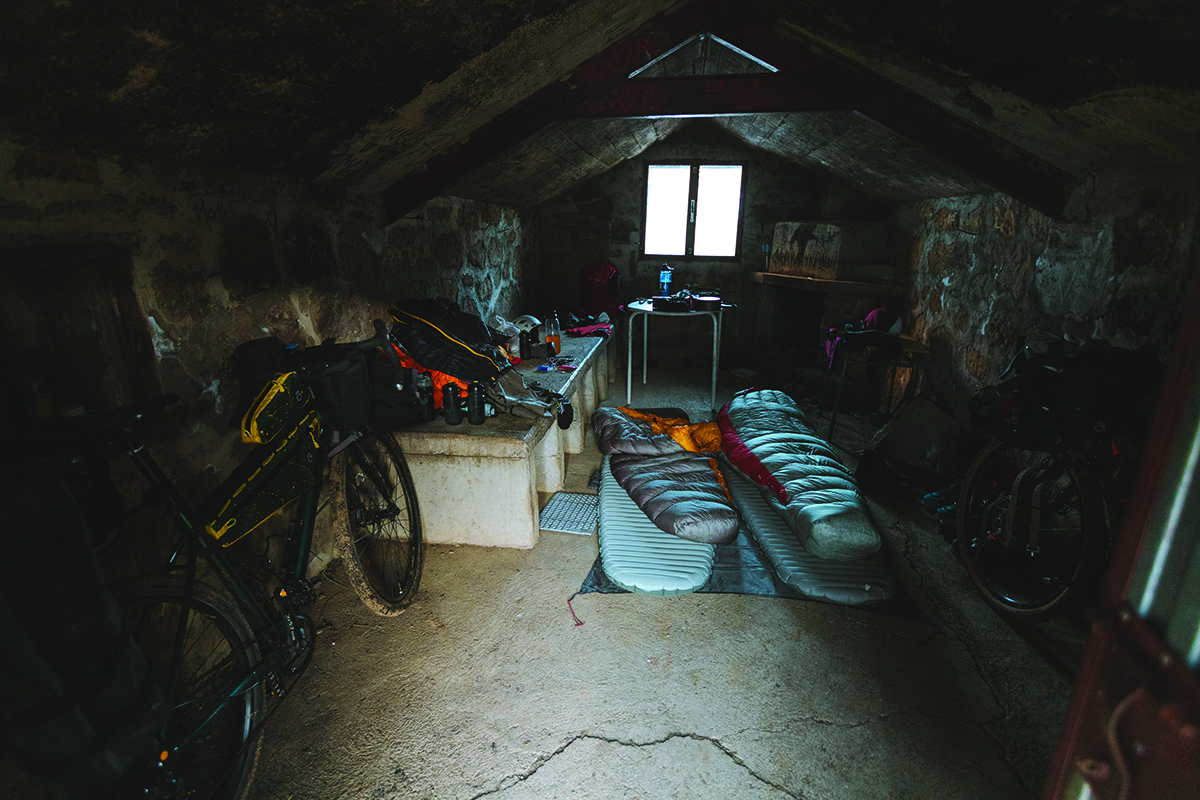
The shadow during the first portion of the ascent helped us a lot by keeping us cool as we needed a longer warm-up to get adapted to the gravel path. As soon as we climbed, trees receded, the sun intensified, and the views got better. The lowlands were getting greener while the high peaks were still covered with snow. We did not yet see the peak and the area we wanted to ski tour, but we could make out some of the lifts from Panticosa ski resort. These days were the last of the season, and the slopes were surviving with the thinnest layer of snow I have ever seen in a resort. We continued cycling up, enjoying the views and how the scenery kept changing as we gained altitude. The first break came by midday when we found a cold, crystalline mountain stream, the ideal scene for lunch and a refreshing dip. Meanwhile, the sound of the marmots and the smell of the mountains created an ambience that reminded us that spring was just around the corner.
Intermittent downhill stretches provided respite for our legs and gave our eyes a chance to bathe in the beauty of the place. On one side, you could find the river and its steady sound by a big, green field almost ready to bloom; the other boasted brown and gray stone walls rising majestically. A cascade of snowcapped peaks, crowned with the mountain we sought, gradually emerged. At last, we could see our base camp for the following days in the distance. We got ready for the last stretch of our cycling adventure with big smiles on our faces.
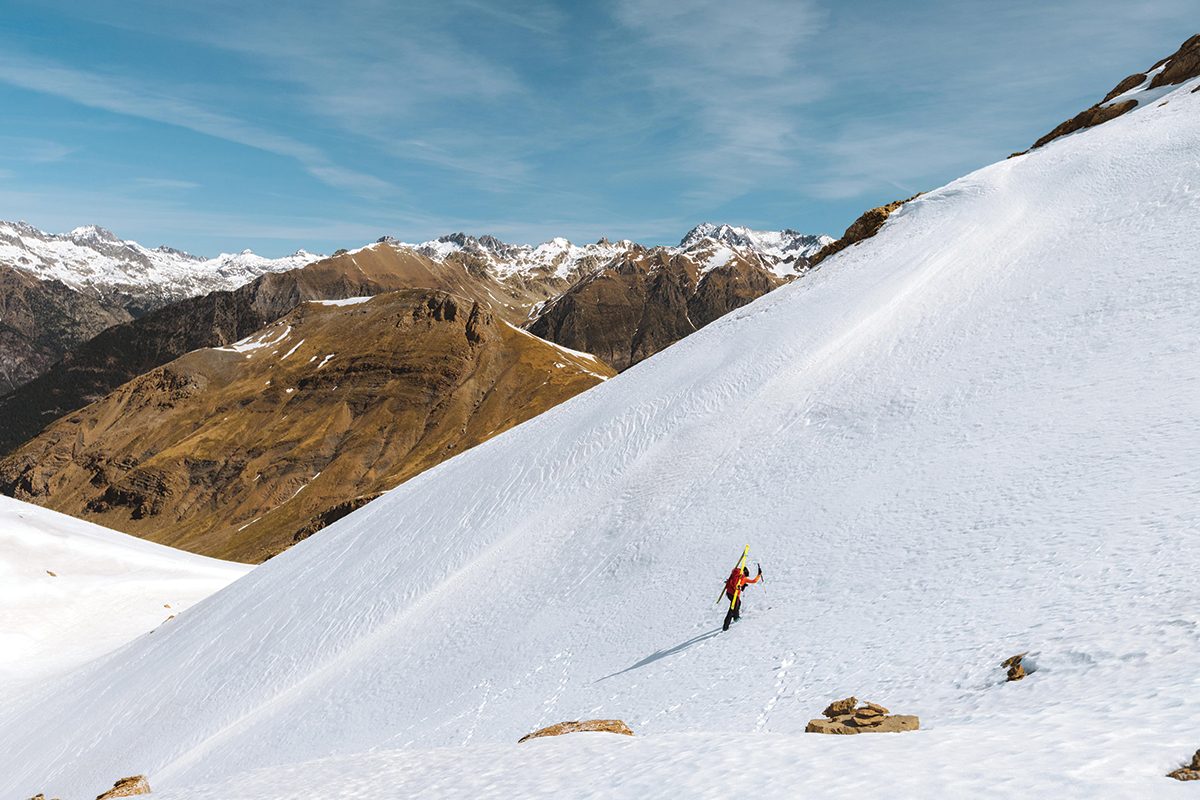
The valley turned west on the following big slope. It required brief pushing due to steep terrain and sizable rocks. The path we followed zigzagged across challenges like sticky mud and snow-cloaked paths. We again pushed the bikes over the snow, leaving an even track on it. Screams of joy, wet feet, stunning views, and startled-looking marmots were all there was in the scene. I suppose we were some of the first human visitors that these marmots had seen this season. They seemed to wake up from their lethargy after the uncharacteristically dry winter because we saw them running around and hiding in their underground city when they noticed our presence.
At base camp — our refuge — we were greeted by more breathtaking vistas. A big granite and slate stone wall facing north by the cabin made us feel elfin. Although this open shelter served well as storage for our cycling and camping gear — keeping our fingers crossed for not having any issues as it remained open — we were eager to explore farther on skis. Originally aiming for Tendeñera Peak, we redirected to explore nearby slopes in order to avoid thin snow and long approach routes. We decided to go farther west and wear our skis directly from the hut the next day.
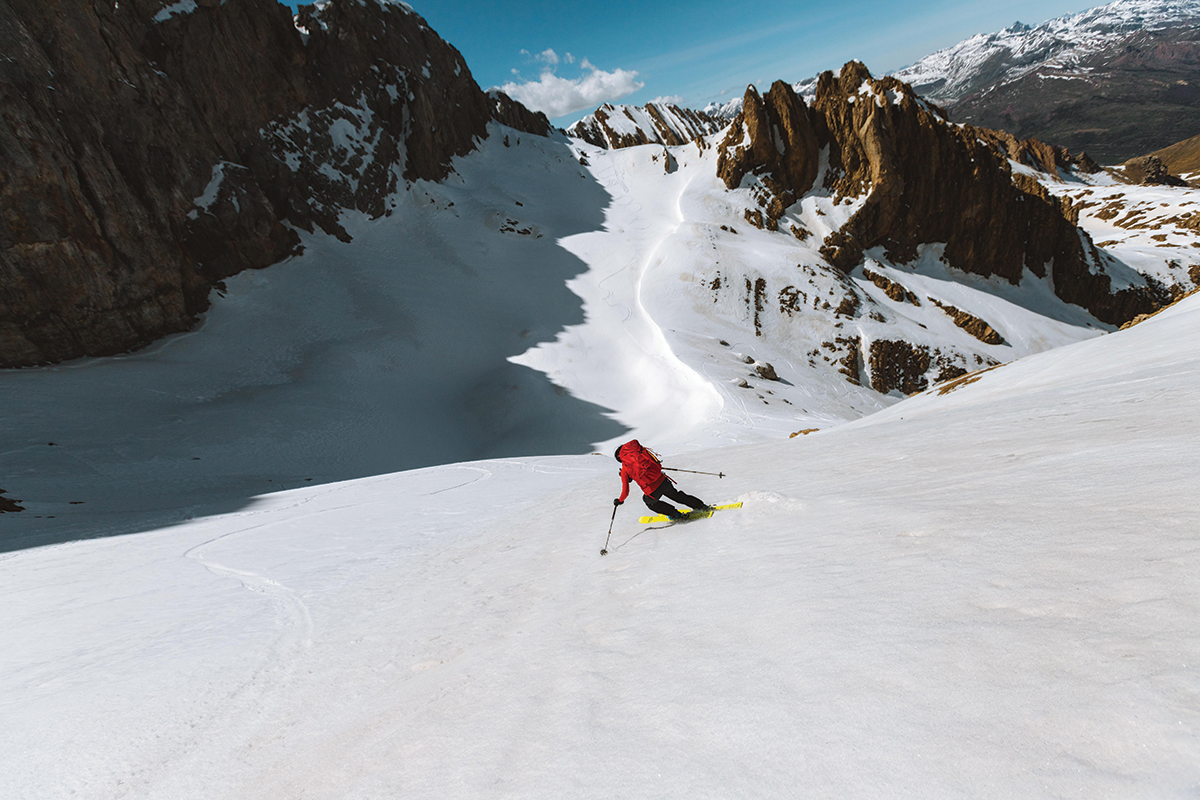
The first sunset and blue hour were as epic as the views, but our sleep that night was poor. Although we had winter sleeping gear, the hut retained the winter’s chill. It was nothing that the energy of first sun rays and a great breakfast couldn’t solve, and soon we were sliding skis over snow. A narrow snow ribbon expanded into a field of white as our progress continued.
Situated at 9,045 feet on the western fringes of Sierra Tendeñera, Peña Sabocos typified the robust relief of the western Pyrenees with tall limestone peaks on its northern side. The more we climbed, the more expansive our perception of the mountain and valley became. Although we also felt quite strong during the ascent, we still took a few breaks on the way. The flattest part of the ski tour came to an end with big-gradient slopes ahead. Choosing to be closer to the wall of the mountain not only forced us to trade our skis for crampons but also put us in shadow. We skirted these slopes by making diagonal walks until the time we reached the foot of the mountain, bathed once again in sunlight. The expansive views we had in front of us afforded a glimpse of the first two other people we would see on our adventure. They were on the ridge before the top, between the descent couloir and the final big climb. A quick snack before heading up gave us enough energy to conquer the first part of our Sabocos attempt.
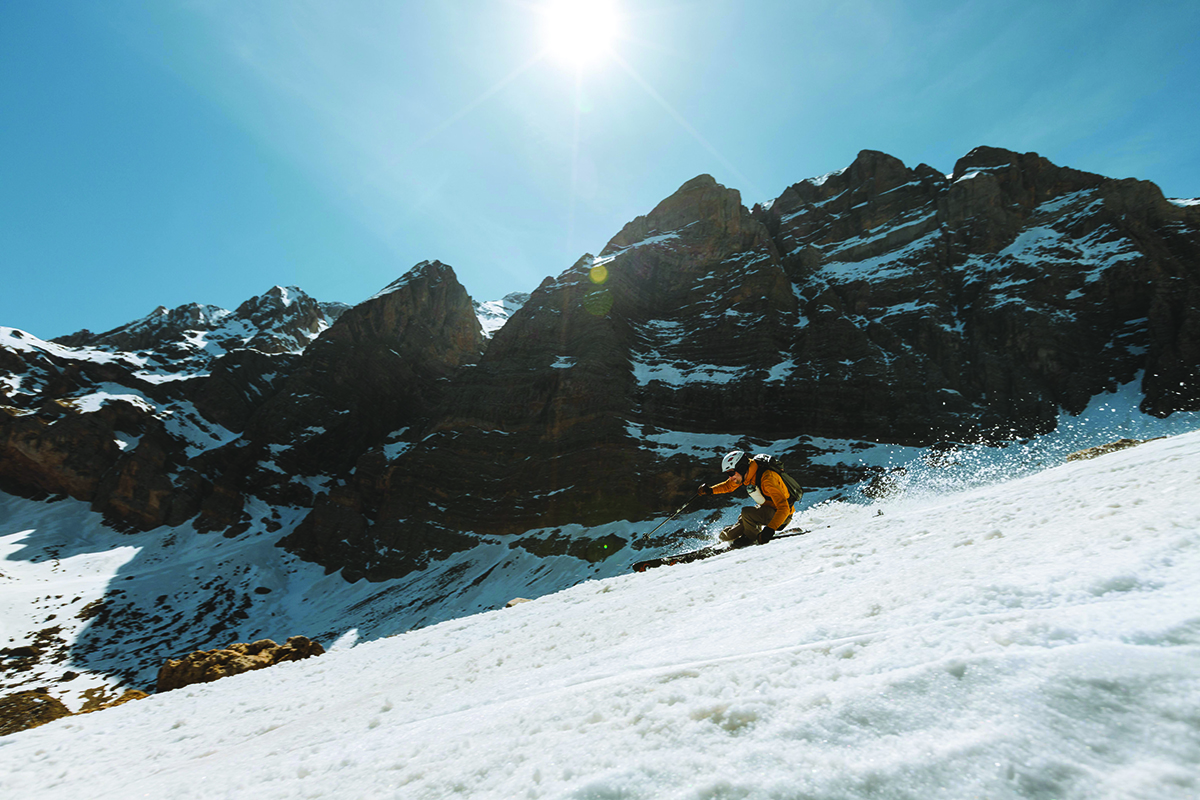
Skis mounted once again, we reached the place where we would see these two guys later. An enormous granite wall lined up from the top to the following ridge, naturally drawing a half circle. As the sun moved, the great wall’s shadow gained ground again. Time to put on our jackets, enjoy the freezing breeze as well as some olives, a good sandwich, and some pieces of chocolate for dessert. We could not ask for more: great food with great views and a long slope ahead up to 8,980 feet. We could see the Tena Valley unfolding behind us, and the Sabocos and Asnos lakes twinkled below. The iconic Midi d’Ossau peak, Sierra de la Collarada, and the incredible panorama of Vignemale, Ordesa, and Monte Perdido were also within view. These sights made the last climb smoother.
Removing the skins from our skis and putting our jackets back on took us longer than the first descent. The preparation to ski took longer than the ski itself, and with the snow softened by the sun, we were able to enjoy our first downhill with cheers.
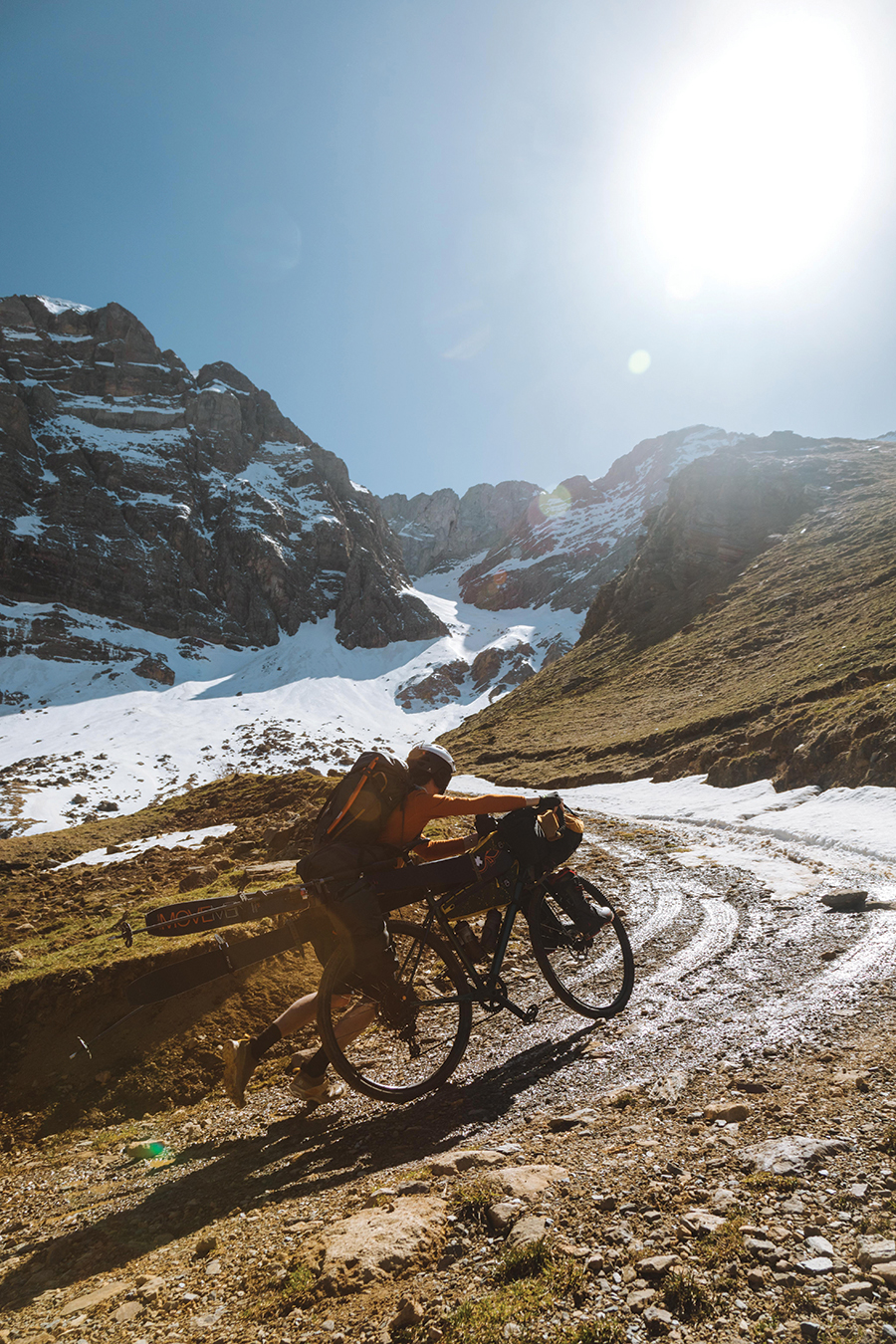
We knew that all types of snow would be waiting for us on the way down. We are used to it in the Pyrenees as we generally don’t get the best snow. We encountered ice and hard snow, requiring attentiveness on steep and narrow sections, especially for me. “There is no such thing as bad snow, only bad skiers” is an adage among skiers, and we were happy to pass the test.
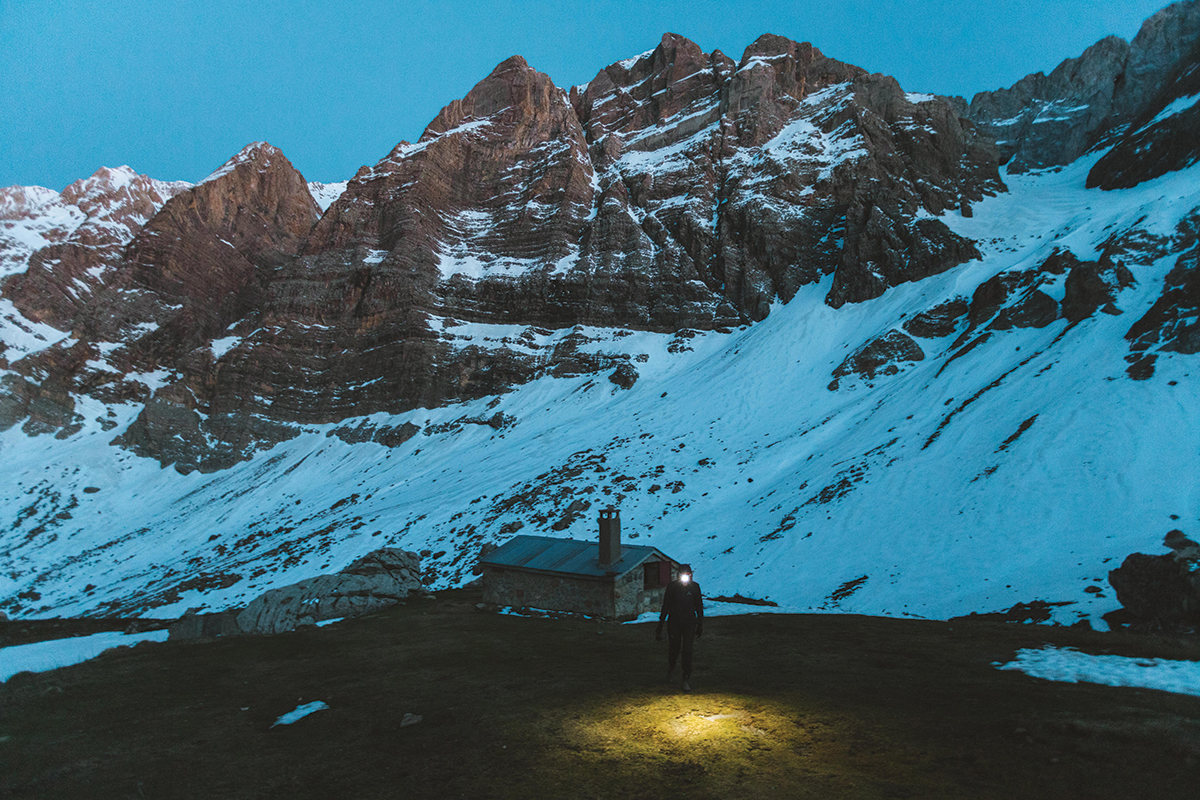
The sun felt less strong than in the morning. We continued skiing until we reached our base camp where all our gear was waiting for us. We could see and feel how much snow had already melted within the last 10 or so hours. The river gave us clean water, the sun an amazing sunset. We finished the evening with some food, happy moods, tired bodies, and a peaceful sleep.
We decided to take a less intense third day as the gravel and skiing experience fully filled our souls during the first two. Our bodies felt exhausted and needed rest, so we decided to enjoy a couple of the snow blocks that were still near the refuge to do some short, fun descents. We walked up the grass and skied down in an exhilarating cycle. Tiny patches of snow had never been so fun!
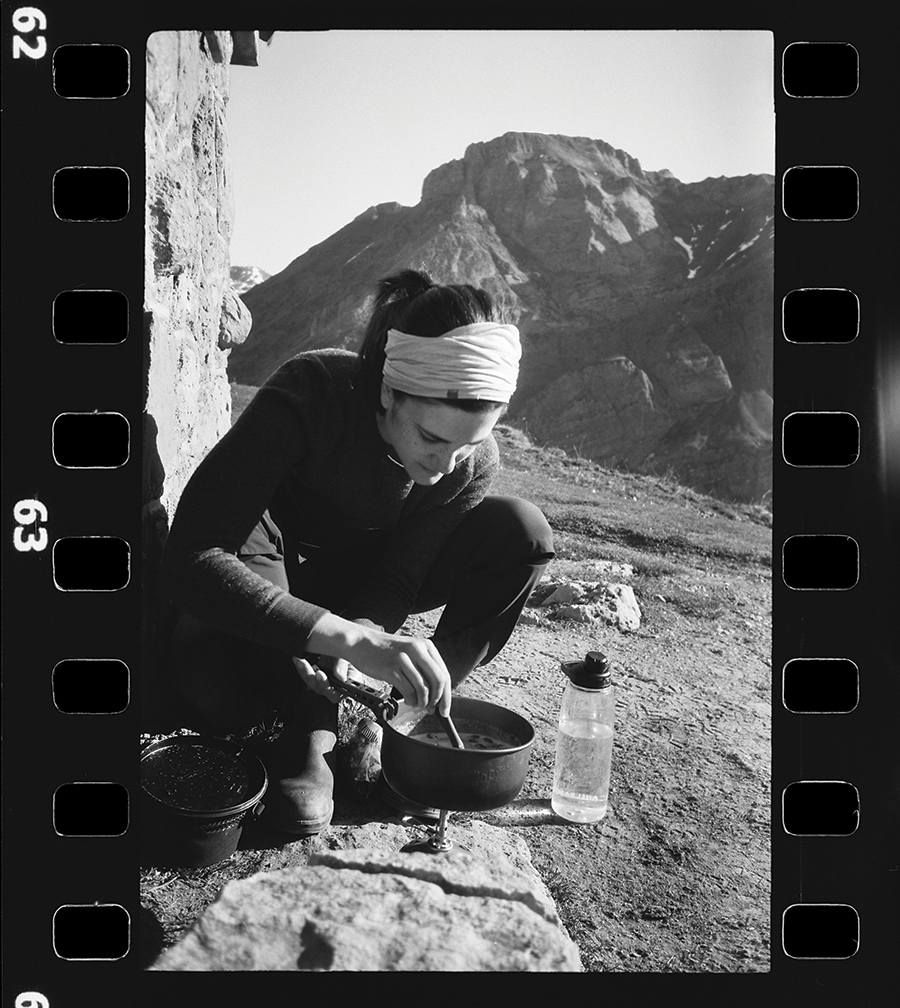
Our final day of this great adventure took us all the way down to the valley floor on two wheels. We had 3,600 feet to descend back to the dam we started from. The heavy backpacks containing most of our ski gear limited our ability to enjoy the views while going downhill — if you’ve never cycled with a loaded pack, they seriously limit your ability to look upward while in the saddle — and the bumpy mountain road demanded most of our attention. A crash with all the extra gear strapped to us and our bikes would have been interesting. For example, we strapped our boots to our forks and skis to our bike frames. That’s why we stopped many times to take breaks and enjoy the scenery, giving our stiff arms a rest from hitting the brakes. The first slopes were the most challenging, as we had to adapt to the weight pushing us downhill. The mud in the first few miles didn’t help much, as the snow was melting quickly, and a few creeks made the path a bit more challenging. The empty valley surprised us in ways we loved. A crystal-clear river awaited us for another refreshing dip, and we bade farewell to the marmots as they watched us go.
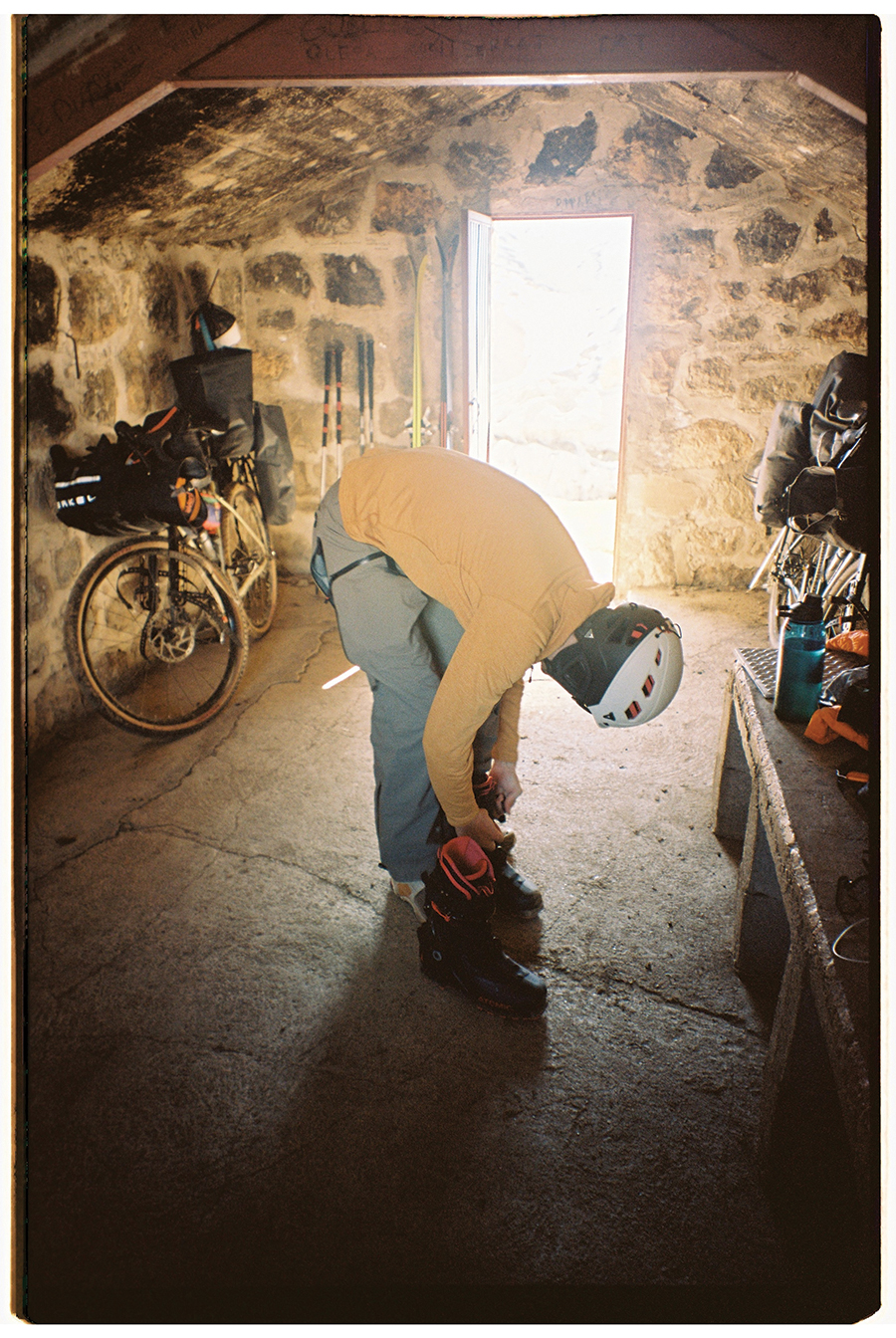
A last-minute decision concluded our adventure ahead of schedule. Faced with two excellent options, we chose to close the ski season early and exchange more action for some good old-fashioned sentimentality — we shared a skiing day with a young family member who is improving his skills and will likely be a better skier than us in the very near future.
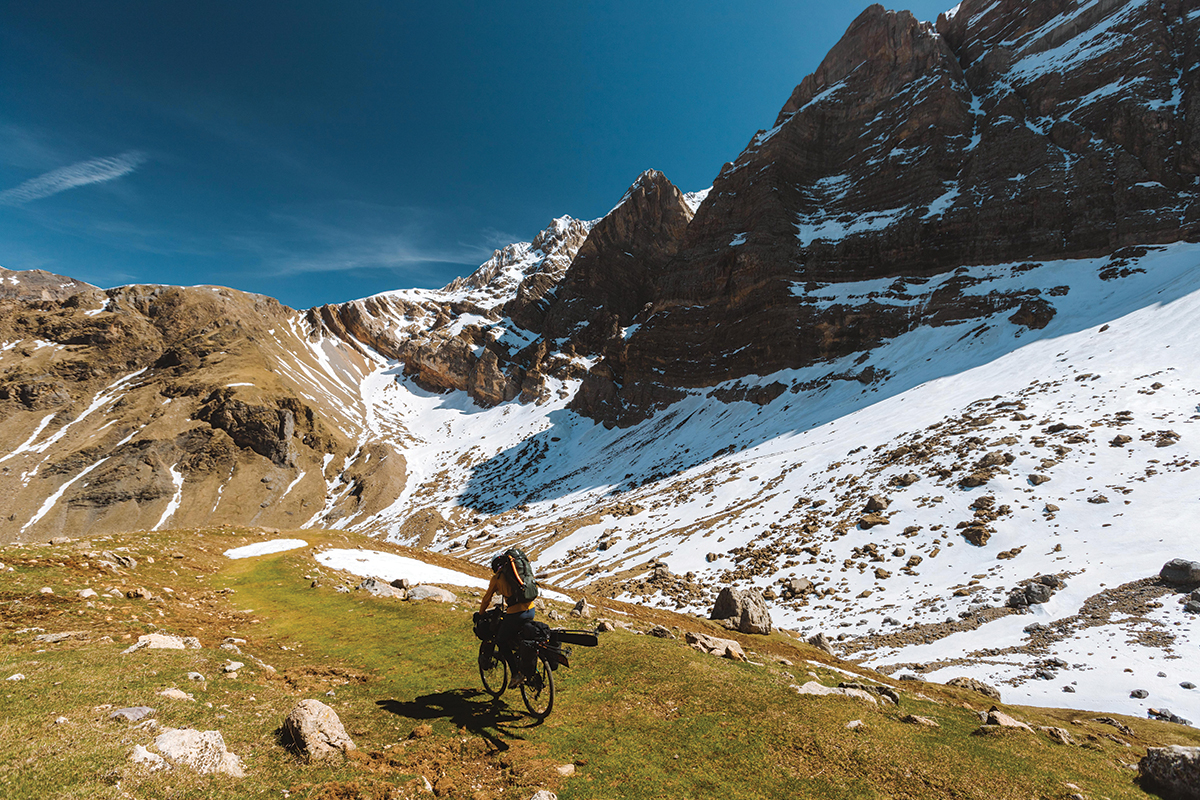
The Pyrenees have become our favorite playground, not only for winter but also for cycling in spring or autumn. This range is one of the most underestimated mountain ranges in Europe, not so much because of its natural features and rugged beauty but because Spain has long been promoted as the “Sun Country” of Europe, with pictures of beaches, great gastronomy, bars, and warm weather. Some parts of Spain indeed provide this weather all year round, but other parts like the Pyrenees offer very different landscapes, with glaciers, mountains, and raw nature. We chose the Tena Valley for the endless possibilities to blend bikepacking with ski touring that it offers. Many gravel roads lead to the snow level and are perfect for ditching bikes for skis. This is a reminder that a great adventure doesn’t need many days but rather some creativity and the right playground to ski and cycle on.

